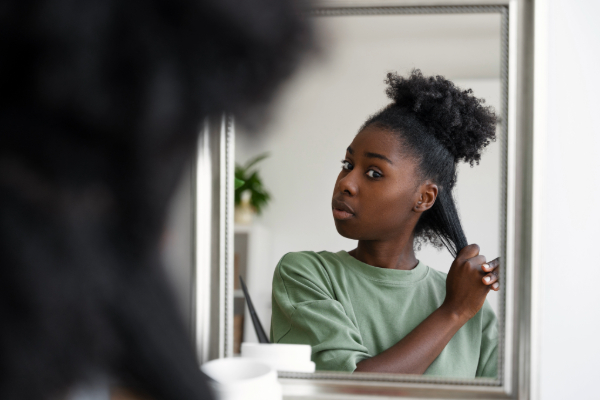13 January 2025
Spotting the Early Signs of Hair Loss: What You Need to Know
Hair loss can be a gradual process, often sneaking up on us before we realise it. But the earlier you spot the signs, the better your chances of manage it.
Being aware of the subtle changes in your hair can help you act sooner, potentially slowing down or even reversing the effects.
Common Early Signs of Hair Loss
Here are some common early signs of hair loss to watch out for, along with tips on what you can do if you notice them:
1. Finding More Hair in Your Brush or Shower
It’s normal to shed around 20-100 hairs a day, but have you noticed an increase? Maybe your hairbrush seems fuller, there’s more hair collecting in the shower drain, or you’re finding more strands on your pillow. Excessive hair shedding is often one of the earliest indicators of hair loss. Early awareness can lead to early intervention, which makes a significant difference in managing hair loss.
2. Thinning at the Hairline or Crown
For many, a receding hairline or thinning hair at the crown is one of the more noticeable early signs, especially among men. If you find yourself styling your hair differently to cover these areas, or if more of your scalp is visible, it could mean your hair is beginning to thin. Addressing thinning hair at the crown early can help slow down the process or in some cases reverse the loss and improve the appearance of your hair.
3. Widening Part
For women, a widening part is a common sign of female pattern baldness. If your usual parting seems to reveal more scalp than before, it might be easy to overlook but is often one of the first signs of hair loss. If you’re adjusting your parting frequently or trying to cover thinning areas, consider looking into hair loss treatments.
4. Hair Feeling Thinner or Lighter
Sometimes, even before visible signs appear, you might feel a change. Does your hair seem less dense when you run your fingers through it? Maybe your hair feels lighter or less voluminous. These sensations can be early clues of progressive hair thinning, even without obvious shedding or bald spots. Noticing these subtle differences early allows you to act before more significant thinning occurs.
5. Irritated or Itchy Scalp
An itchy scalp or frequent scalp irritation can sometimes accompany hair loss. While occasional itchiness is normal, persistent discomfort, especially if paired with other signs, could indicate an issue affecting your hair’s health. Conditions like scalp psoriasis, seborrheic dermatitis or folliculitis can contribute to hair thinning. If scalp irritation is common, it’s worth consulting a professional.
6. Slow or Stalled Hair Growth
Have you noticed that your hair doesn’t grow as quickly as it used to, or has stopped growing past a certain length? Sluggish growth can be a sign that your hair is thinning, often due to hair follicles shrinking or becoming less active. Recognising this early can help you explore options to promote healthier hair growth.
Why Early Action Matters
It’s natural to lose some hair every day, so don’t worry if you spot a few strands here and there. However, if you relate to any of these signs, it might be time to take a closer look at your hair health. Hair loss is often a slow process, but the earlier you address it, the better your chances of managing it effectively. Many people see success when tackling hair loss early through treatments, lifestyle changes, or a combination of both.
Prevention is Better Than Cure
The phrase "prevention is better than cure" is especially true for hair loss. By catching the signs early, you give yourself the best chance to slow down the process, preserve your hair and encourage regrowth. Here are some tips to keep your hair healthy:
- Adopt a Balanced Diet Nutrition supports hair health, so make sure you’re eating protein and getting plenty of vitamins and minerals. A diet rich in iron, zinc and omega-3 fatty acids promotes a healthy hair and scalp.
- Use Gentle Hair Health Products Harsh chemicals can damage hair and lead to thinning. Opt for gentle, nourishing products that protect your strands and scalp.
- Manage Stress High stress levels can lead to hair loss, so
finding ways to relax and unwind is essential. Activities like yoga,
meditation or simple walks can help reduce stress, which is linked to
healthier hair growth.
- Consult a Professional If you’re concerned, don’t hesitate to reach out to a hair and scalp specialist. They can identify the cause and suggest effective options like hair restoration treatments, topical solutions, or scalp therapies.
Final Thoughts on Managing Hair Loss
Hair loss is a common issue, but it’s also manageable, especially when you catch it early. If you’ve noticed any of the signs mentioned above, consider developing a plan of action. Whether it’s incorporating the right products, seeking professional advice, or making small but effective changes to your routine and or your diet, there are plenty of ways to support your hair’s health.
Remember, there’s no need to feel discouraged if you notice signs of thinning hair. You’re not alone, and with the right approach, you can regain confidence and take control. At Hove Hair Clinic, we offer guidance, support and solutions to help you on your journey to healthier, fuller hair.
For more advice and to learn about effective hair loss treatments, call 01273 711140 today to book a consultation.
